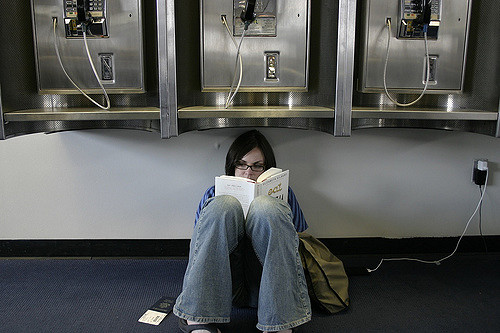 We’ve all seen the image of the folks sitting on the floor at the airport charging their devices. Yes, that’s where we are at: hyper-aware of every plug in case we run down the charge on some electronic gizmo we are carrying, especially our phones.
We’ve all seen the image of the folks sitting on the floor at the airport charging their devices. Yes, that’s where we are at: hyper-aware of every plug in case we run down the charge on some electronic gizmo we are carrying, especially our phones.
Batteries everywhere
I’d like to point out that our electrical anxiety will only get worse: in addition to our phones, we now gripe about the battery life of our cars and watches.
Though I’d like to point out that this is all silly.
Phones: back in the day, phones would last days with a charge. Now that we live in an always-connected, smartphone-guided world, we seem to be fine that we need to top off our phones every night, if not also in the afternoon before when we head out for evening activities.[1]
Watches: Millennials might be surprised to hear that analog watches usually need to be recharged every day. They get recharged by winding of some sort, either manually or with an internal weight that automatically winds the watch. The funny thing is that the automatic winder is sort of a nudge to keep active. If you don’t move enough, the watch ends up dying.[2]
Cars: I drive a car that has to be recharged every few hundred miles. With gas, though. OK, so the phone and watch folks worrying about charging are a bit silly. Cars still have the issue of low numbers of charging stations and charging speed, so perhaps that anxiety is well-founded. But electric car manufacturers repeatedly state that, due to typical driving habits, most folks will be near a charger most times. Nonetheless, there is still some behavior modification required.[3]
Electric anxiety
Behavior modification is fine, so long as it isn’t onerous. And business should be more astute to the underlying electrical needs of the modern human. For example, why do most hotels and airports hide all their electrical outlets?
Also, we need to realize that our anxieties about electrical longevity are a bit silly, since we already have habits that require daily tending of our non-electrical gadgets. The problem is trying to compare the electrical to the non-electrical.
Finally, and more interesting to me, we need to be smart designing how long things last on battery. Particularly, a daily need to charge a watch will likely work better than a cadence that doesn’t match our charging habits, or charging ease. Hence, I wonder if there will be more complaints with batteries that need to be charged at an interval that isn’t daily or weekly, or one that is longer than 10 days. That cadence won’t be in line with other things we anxiously keep charged.
Don’t you think? How many gadgets do you have to keep charged these days?
[1] I always carry a battery pack. But then, I always carried an extra phone battery back in the day. [2] Here’s a smartwatch with analog self-charging. Let’s see if it works. But clever idea, and the article that triggered this post. [3] Seems like these cross-country drivers solved their charger-access issue.Image: Shane Adams